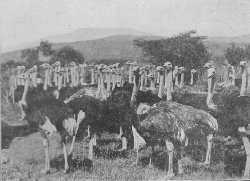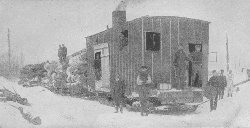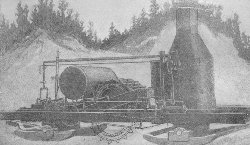|
The antiquity of the ostrich (Struthio Camelus) is attested by its mention in the Bible. Herodotus also refers to a custom of a certain desert tribe in Lybia, of making garments and shields from ostrich skins, and warriors from a very early period wore ostrich plumes in their helmets.
In its wild state the ostrich is omnivorous. It greedily devours seeds, berries, fruit, grass, leaves, beetles, locusts, small birds and animals, snakes, lizards, sand, grit, bones, stones and pieces of metal. According to the Arab, the complement of eggs on which the solitary ostrich sits at night for hatching its young, is 25 in number, but few nests have been found containing more than sixteen. Each egg weighs about 3½ pounds. The male ostriches are polygamous, and fight vigorously in the breeding season for the possession of the females. Each male ostrich associates with three or four hens all of which lay their eggs in one large nest, scooped out in the sand, and relieve each other by turns at incubation. The period of incubation is six weeks, and the male bird takes his regular turn in sitting on the eggs, late in the evening. The young run as soon as hatched. The shell being thick and strong, is used in various ways, but mainly as a vessel for water. Bush girls and Bakahari women, who belong to the wandering Beckuana tribes of the Kalahari district, carry from their dwellings, to the fountains a kaross or net containing from 12 to 15 eggshells, with a small aperture at the end which, after filling with water, they stop up with grass. More than a century ago many farmers at the Cape had tame ostriches on their farms, which fed at large and supplied their owners with plumes, which were made into brooms for driving away the mosquitoes. In 1859 the Acclimatisation Society of Paris offered premiums for the successful domestication of the ostrich in Algeria or Senegal, and for breeding ostriches in Europe. From 1866 the new industry of ostrich farming spread and flourished throughout Cape Colony, although in 1865 there were less than 100 domesticated ostriches in Africa. About twelve ostriches are able to subsist upon an acre of garden ground, sown with lucerne and well watered. Three pluckings from 15 ostriches, at intervals of 8 months, yielded the owner of one of these farms £240, which is at the rate of £120 a year, or £8 per bird. England and France pay to the Cape Colony farmers $8,000,000 a year for feathers, and buyers in the United States pay $2,000,000 a year. Loose stone walls, costing from a shilling to 18 pence per yard, or fences composed of four horizontal wires of galvanized iron, surround the ostrich enclosures. A full grown male ostrich will yield about 90 first-class feathers, which will weigh one pound and sell for about £45. Second-class feathers are worth from £20 to £30 per pound. The ostrich is a solitary bird, timid and shy in habit, but often headstrong. When at full speed and going before the wind, its pace is simply amazing, and it is said that no horse ever fairly ran one down. An enterprising man named Edwin Cawston established an ostrich farm about 10 years ago in Pasadena, California. In a miniature park he has 100 mature ostriches, and several rooms full of incubators. Mr. Cawston receives annually $10,000 as admission fees from spectators, and $3,000 a year f rom the sale of infant ostriches, which are sold at $25 each. LOGGING IN THE NORTHWEST—IN THE EARLY DAYS
The old camp, as it used to be built from 1848 to 1860, was simple but very handy. Two large trees, of the full length of the camp, were procured and placed about 20 feet apart and two base logs were cut for the ends. Each end was run up to a peak like the gable of a house, but each side slanted up as a roof, from the long base tree at the ground to the ridgepole. This roof, constructed with level stringers, was shingled. A chimney measuring about four by six feet formed of round poles and calked was built in the middle of the roof and the fire was directly underneath it in the middle of the room.
The places for sleeping were next to the wall behind benches of hewn planks built near the fire, and the bed consisted of fir boughs laid on the ground. The modern logging outfit is different. Two bobsleds are placed one behind the other and are fastened by two chains crossed in the center. With a tackle and fall, logs are rolled up and loaded on these sleds, sometimes to the height of ten feet. Horses or oxen are used on the tackle, and a load takes from four to ten thousand feet of logs. It is made possible to draw these very heavy loads by icing the ruts of the logging roads. At the beginning of the logging season, and whenever snowstorms or continued wearing makes it necessary, water tanks on runners are drawn along the roads, supplying a small stream at each side. The resulting narrow courses of ice bear up the sleds under the great weight. Instead of shopping down the trees as in the olden time, they are now sawed off at the stump. BOOK V |


